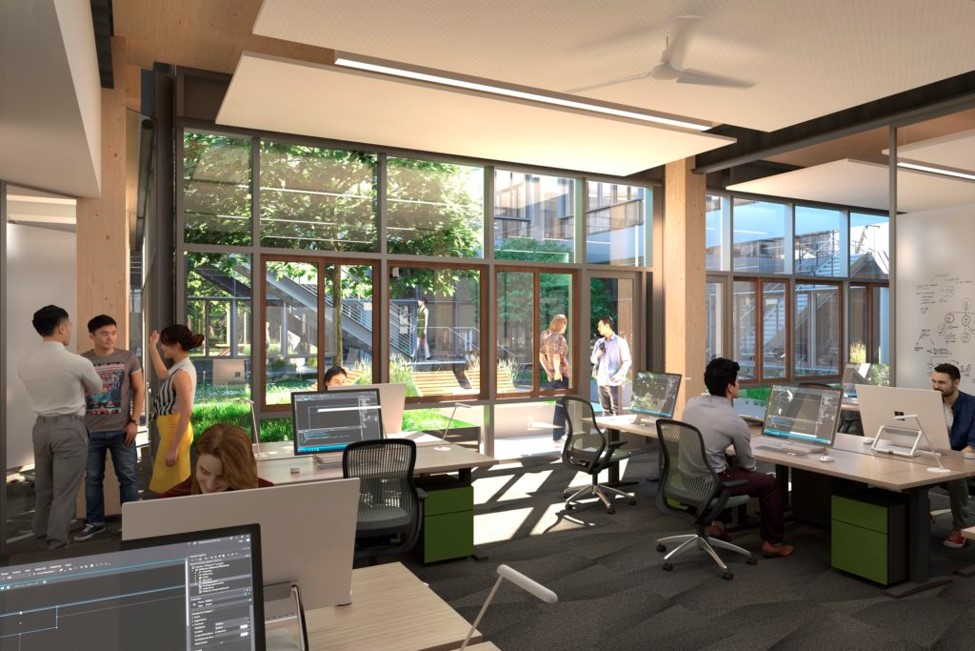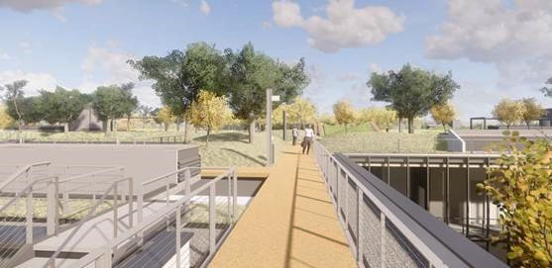Design a structure that will stand the test of time, allow for people to be alone while still together, foster community across teams, and give back to the local ecosystem.
This was the challenge presented when our local teams were given a once-in-a-generation opportunity to transform the Microsoft employee experience through innovative design. The new Silicon Valley Campus (SVC) was created for employees to do exceptional work, designed to focus on keeping our evolving culture in mind – one that will result in a workplace that enables and celebrates community, collaboration, employee wellness, and sustainability.
Collaboration through design
Workspaces today need to support quick decision-making, enable fast release cycles and new development models, and maximize responsiveness to customers. With employees hyper-focused on the task at hand, design needs to drive people together and help spark creativity.
Brenda Ball, Microsoft regional workplace strategist, was integral in designing SVC workspaces to accommodate this type of modern working style. “The design needed to provide employees and small teams space to do highly concentrative tasks,” she says. “We gave them distance through acoustical separation but connected them with line of sight, which helps drive interaction between teammates.”
This is where the courtyard, the core concept for our 640,000 square foot campus, excels. It moves away from the modern-day high-rise structure and encourages social connection through direct interaction. Any one team looks out through large glass windows onto a green courtyard that it shares with three other teams. The multiple courtyards create a neighborhood feel that encourage exploration to new places for inspiration.
“Teams are both visually and physically connected to each other, even as they have their own space,” says Kyle Elliott, a partner at WRNS, the design firm that helped bring Microsoft’s SVC vision to life.

(Mockup of our courtyard design concept, meant to create a connection to others as well as the outside world © WRNS Studio)
Respecting individual and local environments
Each floor, outside of a team’s neighborhood, are various shared and community spaces. These include traditional meeting spaces for those used to working in a focus or conference room, but also modern work zones intended to make employees feel like they’re at home.
Creating different types of working space across the campus helps drive exploration. “Whether someone wants to work in a living room, barista café, under the sun, or in a conference room, we have those options for employees,” Ball says. Different food venues across the campus also encourage movement, like how one might explore a different part of a city.
Along with recognizing each person’s unique work style, the design respects the surrounding environment. The campus won’t be visually conspicuous from the road. In fact, one of its more prominent features helps the campus blend into the local surroundings. The three-acre green roof atop the structure is planted with vegetation meant to bring back the original habitat of the surrounding Stevens Creek ecosystem. Biologists, botanists, ornithologists, and other scientists all were consulted in the development and planning of the roofscapes and courtyards.
“We have a strong and innate desire to be connected with nature,” says Katie Ross, senior sustainability program manager at Microsoft “Not only does this connection have a positive impact on employee happiness and cognitive function, it also engenders a deep respect for and need to protect our environment.”

(The eco-friendly, living roof not only rebuilds the native habitat around Stevens Creek, but also provides a place where employees can gather, walk, or lounge throughout the day © WRNS Studio)
Designs throughout the ages had specific shapes or were made to be seen. “Working to design a campus with such a singular goal and focus on blending into the natural habitat has been a distinct privilege,” says Elliott.
This summer teams in the Mountain View area like HoloLens, Azure, Silicon, Teams, and PowerPoint will finally get to experience the campus courtyard concept. If you’re interested in joining them to explore the campus for yourself, open roles in the Bay Area can be found here: https://aka.ms/MicrosoftBayAreaCareers.



